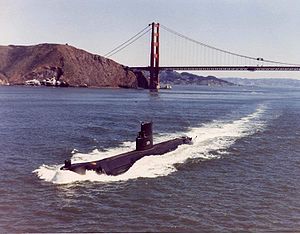Part 1 of 2 Parts
I have blogged about nuclear submarines in the arsenals of nuclear-armed nations before. The Chinese, Russians, U.K, France, the U.S., Pakistan and India all have nuclear submarines that can launch nuclear-tipped missiles. These constitute a leg of what is called the nuclear triad. The other two legs are nuclear bombers and ICBM with nuclear warheads. The nuclear submarines are seen as providing the ultimate retaliation capability if the other two legs of the nuclear triad have been destroyed by an enemy. Today, I am going to talk about the most advanced nuclear submarine possessed by the U.S. Navy.
By the late 1950s, the Soviet navy had nuclear powered submarines that could reach twice the maximum depth of most of the U.S. subs. Often the Soviet subs had a higher maximum speed. However, despite these advantages, they had a very significant disadvantage against U.S. subs. The Soviet subs were a lot noisier.
U.S. subs were able to easily detect and trail Soviet subs from a distance that made the U.S. subs undetectable by the Soviet subs. However, by the 1980s, the Soviets were improving their acoustic stealth technology. The Soviet Navy had acquired propeller-milling technology from Toshiba and Kongsberg companies. This allowed the Soviets to create a much quieter seven bladed propeller on their new Akula-class subs.
The Pentagon concluded that the Akula-class subs had superior specification to most of the Los Angles-class subs that constituted the majority of operational U.S. subs. In 1983, the U.S. began development of the biggest, fastest, and quietest attack submarine they could imagine to regain U.S. superiority over Soviet Subs.
The construction of the U.S.S. Seawolf began at Electric Boats in October of 1989. It would be about three hundred and fifty feet long which is more than a football field and displace over nine thousand tons when submerged. The Los Angeles-class subs carried thirty seven torpedoes in four tubes. The Seawolf was armed with fifty heavy-weight 533-millimeter Mark 48 torpedoes or Harpoon anti-ship missiles. These could be launched from eight extra-large 660 mm torpedo tubes. Surface-attack Tomahawk missiles could also be launched from these tubes.
The Seawolf-class of subs is made of a special high strength steel called HY-100. Its conning tower is reinforced so it can cope with operations in Arctic Ice. The S6W pressurized water reactor gives the Seawolf-class an incredible forty miles per hour top speed that allow it to chase down any sub currently in the arsenal of any other country.
The most important advanced technology incorporated in the Seawolf-class involved acoustic stealth. The Seawolf-class generates one tenth of the noise of the quietest Los Angeles-class subs. The Seawolf-class generates about ninety-five decibels in the ocean where the background noise is ninety decibels.
In addition, the Seawolf-class utilizes a jet propulsion pump system instead of the standard propellers that powered the Los Angeles-class. This means that the Seawolf-class can maintain its super quiet operation even traveling at twenty-three miles per hour which is much faster than other subs could travel while remaining in stealth mode.
The Seawolf-class has a twenty-four-foot diameter spherical sonar array on its bow. It also has wide-aperture flank arrays and can tow TB-16D and TB-29 sonar arrays. The information gained by these sensors is fed to the BSY-2 combat system on the Seawolf-class. The Seawolf-class can engage multiple targets simultaneously with their Mark 48 torpedoes. The Mark 48 can be guided by wire from the sub or with their own sonar.
Please read Part 2 next
